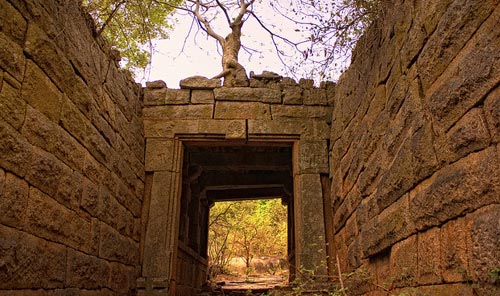Rachakonda Fort

Information on Rachakonda Fort (Nalgonda, Telangana) - History & Architecture
Rachakonda Fort is a hilltop fort built by Recherla Singama Nayak, previously served in the great Kakathiya kingdom as Commandos. It is the 14th century fort and was the capital Velama Kings. This fortress was a frontier fort and acted as a neutral zone in times of battles indulged with the Bhamani's and the Vijaya Nagara kingdoms. It is located near Devarakonda Town in Nalgonda District of Telangana State in India.
Rachakonda Fort Architecture
Rachakonda Fort has the traditional Dravidian architecture with the traces of remarkable Mycenaean architecture. This fort also used the structural dynamics known in the Hindu Vasthu Vashtra. These types of works are found in the Cyclopean masonry of the Greeks. Who brought this technique and how it was practiced is still unknown in India. This type of structures does not use a strong bonding mix or paste of compositions used in the ancient times. Instead the structural dynamics are taken care in the placements of stone blocks, which hold them in a rigidly manner. There is a minute gap allowed to fill few bonding paste in the outer areas of the stone blocks only. This fortress is totally built with the granite stones. These stones were quarried from the same areas were the fort is located. This fort is a single storied structure built with strong walls across its citadel mount. The ramparts are found with irregular shaped of stones, which make it to see differently. It has a remarkable gateway built out of a monolith stone. Its arched entrance is really appreciable for its crafts work. It seems that there were many skilled stone artisans efforts used in this fort. This forts plan was for defensive purpose and there are many artillery blocks found on these ramparts. Inside the fortress there are many mandaps. These are of large open plinth areas supported with monolith pillars. The carving work of this pillared make these mandaps look great. There are many small structures found here with stone laden roofs. These are meant of granary and magazine purposes. There is also large living areas found here. All of its inner structures have a well designed stone art works. These are pleasing to our eyes.
Rachakonda Fort History
Rachakonda Fort and is surrounding areas was the capital for the Vellamal's. The town started to develop here as this bastion was formed. Since the medieval time this place was an important trade and commerce centre. This fortress was first attacked by the Bhamanis, who were imposing Islamic rule here. This were taken out by the by the Reddiyar's in the 18th century AD. This area was also ruled by the Nayak's and the Gajapathi kingdom of Orissa. Many battles also fought with its nearest kingdom, the Vijaya Nagara. It is also said in the history that this Velamal kingdom declined in its power due to the bad tantras dispel on these rulers done secretly by them. This fortress area is always indulged with treasure hunters. A 6 feet Siva Linga was taken out by these treasure hunters recently, from the midst of thick cover of vegetation. This came to notice of the public since it was a huge structure which was unable to transport. Now this is under the Archeological department.
Rachakonda Fort Tourism Importance
Rachakonda Fort is of vast connoisseur interest. To reach here, one can get a great trekking experience. This Hill has very good steep slopes and scenic places around it, including the Rachakonda town areas and nearby villages. It is the best place to see the Viswakarma's art forms of Vasthu designs of the Hindus. This is a tourist place for historical and archeological importance.
- Andaman Nicobar Monuments
- Andhra Pradesh Monuments
- Assam Monuments
- Bihar Monuments
- Chhattisgarh Monuments
- New Delhi Monuments
- Goa Monuments
- Gujarat Monuments
- Haryana Monuments
- Himachal Pradesh Monuments
- Jammu and Kashmir Monuments
- Karnataka Monuments
- Kerala Monuments
- Madhya Pradesh Monuments
- Maharashtra Monuments
- Odisha Monuments
- Punjab Monuments
- Rajasthan Monuments
- Tamil Nadu Monuments
- Telangana Monuments
- Uttar Pradesh Monuments
- West Bengal Monuments